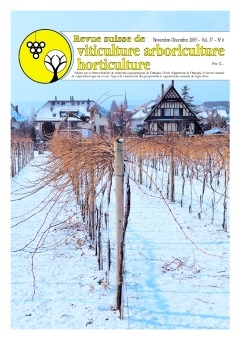
Issue 6 - November - December 2005
Abstract in open access
An experiment on training and pruning systems was set up in 1991 on Pinot noir, Gamay and Chasselas vine plants at the Agroscope RAC Changins experimental estate in Pully (Vaud, Switzerland). For the two red grape varieties of vine, Guyot pruning (single or double) was compared with alternate cordons (alternating long and short cut shoots) and with «open lyre» pruning. In the Chasselas trial, a comparison of single and double Guyot pruning at varying inter-vine distances was made with normal and alternating cordon-pruned systems. Various agronomic, analytical and organoleptic parameters were monitored. From 1997 to 2000, vinifications of red grape vine plants were compared. For all the experimental vines, yield was limited to one cluster per plant. Yield levels were thus similar for all the training and pruning systems studied. Short pruning in cordon-trained plants resulted in reduced bud fertility which, in spite of slightly heavier berries, needed less fruit-thinning operations to obtain required yield levels. At equivalent yields, training system and type of pruning had no significant influence on the quality of grapes and wines. Cordon pruning and lyre training had no noticeable effects on plant strength (expressed by individual weight of plant wood) which was comparable with that of plants pruned in double Guyot. Single Guyot pruned plants proved to be a little more vigorous than double Guyot by Pinot noir and Chasselas vines. Lengthening of shoots was reduced by alternate cordon pruning. Spacing distances between plants along the row did not noticeably influence plant behaviour.
Key words: training and pruning systems, vigor, grape quality, wine quality.
Keywords:
E-Mail: francois.murisier@acw.admin.ch
Adress: Agroscope, 1009 Pully
Abstract in open access
Three Pinot noir plots of vines grafted on various rootstocks (5BB, 5C, Fercal, 41B, 161-49, 420A, 110R, 1103P, SO4 and Börner) were planted in highly calcareous soils (> 60% total lime) in central Wallis, Switzerland, and monitored from 1997 to 2005. In very chlorotic situations, Fercal was the only rootstock that resisted ferric chlorosis satisfactorily. In all three situations, the rootstock Börner grafted vine proved to be too sensitive to chlorosis. In well drained, medium to low chloritic soils, all the grafted vines tested in the present study, except Börner, may be used. There was an initial slow start to development in the grafted vines 41B, 420A and 161-49C, which contributed to a lowering in plant strength. In the productive phase, there was little influence from the grafted vine type on productivity and sugar content in musts. The nitrogen content in musts was influenced by the level of plant strength, which, in turn, is determined by the grafted vine. There was a good correlation between the chlorophyll index of foliage (N-Tester) and visual observations of the intensity of ferric chlorosis.
Key words: grapevine, Pinot noir, rootstock, lime chlorosis, chlorophyll-index.
Keywords:
E-Mail: jean-laurent.spring@agroscope.admin.ch
Adress: Agroscope, 1009 Pully
Abstract in open access
The tartaric stabilization of wines can be achieved by a selective exchange of potassium ions against hydronium ions on zeolites. The charge of metallic cations of the wine besides potassium remains unchanged during the treatment. This minimizes the acidification level of the wine due to the reduction of potassium concentration. The total exchange capacity of the tested zeolite is below the one of commercial ion exchange resins. The treatment on zeolites does not lead to a total decationisation of the wine which allows to avoid extrem pH variations. Unlike the cation exchange on polymeric resins, no potassium is released at the end of the cycle. A treatment with closed circuit can be conceivable without risk of a K-enrichment of wine at the end of the cycle. The appropriate zeolites for the treatment of wines are types with a low aluminium content. Their composition is similar to those of bentonit or kieselgur, products accepted for wine treatment. The wines stabilized on zeoliths for this study have shown no taste alteration.
Key words: tartaric stabilization, zeolites, exchange resins, potassium, wines.
Keywords:
E-Mail:
Adress: Agroscope, 1964 Conthey
Abstract in open access
Three groups of six 13-years-old individual Golden Delicious trained in Vertical Axis, Drilling and Ycare were digitalised in 2004 and 2005 at the Centre des Fougères (VS, Switzerland) of Agroscope RAC Changins. Through a method of measurement developed by the INRA (Centre of Clermont- Ferrand, France) it is possible to obtain an exact three-dimensional reproduction of the trees. Light is analysed with the STAR (Silhouette to Total Area Ratio) of each shoot, obtained by simulation, that characterises precisely the distribution of the light in the tree.
The results highlight the importance of the annual conditions in the evolution of the leaf area, characterised by partial biennal bearing in the second year. In 2004, light distribution was comparable in the three systems, while in 2005 the considerable increase of the leaf area due to the emergence of a great number of vegetative shoots caused differences between treatments. The localisation of these shoots (generally at the margins and at the top of the crowns) resulted in a bad distribution of the fruits along with an average reduction of 40% in the illumination of the generative shoots for the three systems.
The illumination of the potential fructification points becomes insufficient when the leaf area index (LAI) exceeds 3, which was the case for all three systems in 2005. The value reached by the Drilling system was particularly high (LAI = 4,3) and the consequences of shading were particularly perceptible with a reduction of 53% of the generative shoots illumination. The particularly marked biennal bearing marked by a concentration of the generative shoots inside the trees is not directly linked to the training system. This one, however, helps to explain the result.
Key words: 3D digitizing, light distribution, leaf area, biennal bearing, apple, orchard system.
Keywords:
E-Mail:
Adress:

 Download of full issue
Download of full issue
 Download article
Download article